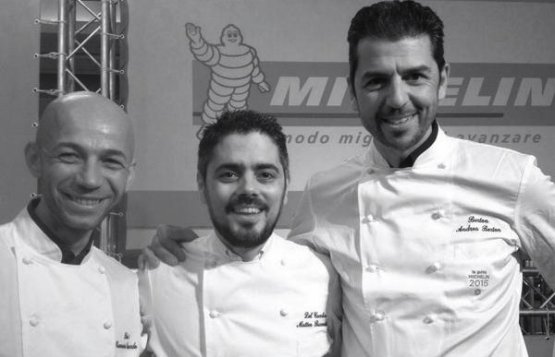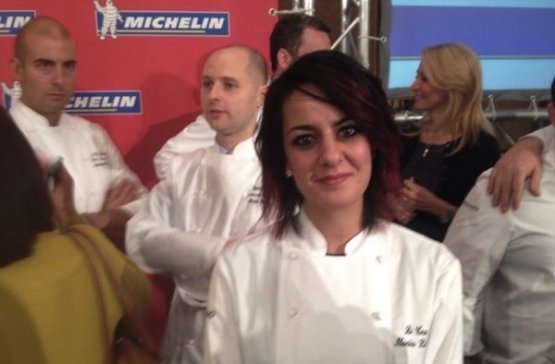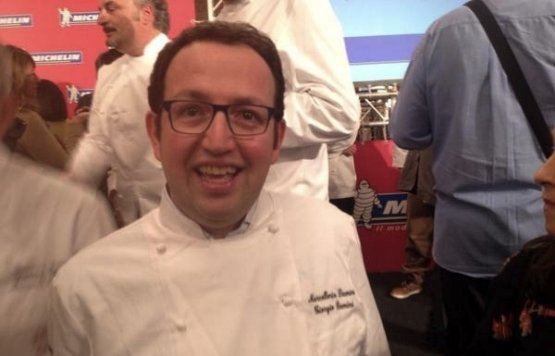The details are now known: the 2014 Guida Michelin Italia, presented this morning in Milan, confirmed all the 2014 restaurants with 3 stars, an elegant way of saying that this year there’s no new entry. It would have been the ninth 3-star, but it is not there, a pause that hadn’t happened for the past 4 years now (last year Niko Romito’s Reale reached the Empyrean, Enrico Crippa’s Piazza Duomo did so in 2013, Massimo Bottura’s Osteria Francescana in 2012). The positive and negative surprises, as we’ll later see, arrived on the lower ground.
The real news is that since this year the editor in chief of Michelin Italia is Sergio Lovrinovich – having reached his second "mandate" – he decided to comment the official results right after the ceremony, together with 3 journalists (2 from the press, 1 from the web, that is to say us at Identità Golose). An unprecedented fact, which demonstrates the Red Guide’s desire to abandon the cryptic aura that has characterised it for decades (centuries), with everyone wondering the reasons behind some choices. Without every getting an answer.
At the end of the conference we joined Lovrinovich on the second floor of the Principe di Savoia hotel. His face (of course), as decided by the publishing house, cannot be made public. As for his words, he proves to be nothing but reticent.
This year you only promoted two establishments to two stars: Taverna Estia near Naples and Piccolo Principe in Viareggio. What did they do to deserve this?
They both proved to have a technique that was much above the average. And they have searched for and reached a rare balance in flavours, in which a great elegance prevailed. Two cuisines from two chefs from the same region, namely Campania, but rather different. Two cuisines which, however, both focus on flavour and substance rather than presentation, in both cases creative.
Have you got some memorable dish worth recalling?
I cannot give you the details.
Il Pellicano in Porto Ercole lost a star, and moved from 2 to one. Is it because of the kitchen or because chef Antonio Guida is leaving?
The cuisine of Mr Guida had no decrease. We would have confirmed the same judgement hadn’t we known about the change with Sebastiano Lombardi [previously the one-star chef at Cielo in Ostuni]. The star was kept because we received sufficient guarantees by the owners and the new chef himself that the quality will be kept high in the new season. We can guarantee that in that house the level will be in the future that of a star, at least.

GUALTIERO’S SONS. Riccardo Camanini (Lido 84 on Lake Garda), Matteo Baronetto(Del Cambio in Torino) and Andrea Berton (Berton in Milan). Three new stars that meet again 20 years after working together with Gualtiero Marchesi in Erbusco
This restaurant, instead, did the opposite than the restaurants that moved from one to two stars. In the many dining-tests we took, we always noticed impeccable raw materials but a balance among these was missing, that extra touch, that elegance we look for in every experience. And not on just one dish or one meal. Before downgrading a restaurant, we always test it numerous times, with different inspectors.
Among the establishments that lost the only star they had, instead, the downgrading of Lucio Pompili’s Symposium in the Marche stands out, as this is a historically important establishment.
I cannot speak of a chef in particular, it wouldn’t be fair. Should a chef want to know the reason of a defection, I’m ready to explain everything.
Among the positive changes, there’s the Michelin star awarded, for the first time, to a butcher, namely Damini e Affini in Arzignano. Is the Red Guide starting to look in favour at non-conventional establishments?
Yes. And I’d also add the star given to the Imbuto in Lucca, another unique establishment thanks to its setting. There is a design table, but made of cardboard. Food evolves: one can find high quality dining in non-conventional settings.
There were no new three-stars. Was anyone close?
Indeed, more than one.
Can you tell us who?
Of course not. But all the restaurants with two stars are potentially capable of getting a third one. In theory, this also applies to those that only have one.
I will not insist. Can you tell us what are the criticalities in the Italian restaurant scene?
The absence of consistency, in the same meal, and after some time. Many important restaurants have a menu with extraordinary dishes but then cannot keep the same high level throughout the courses. And establishments that 6 months ago guaranteed an extraordinary meal, perhaps yesterday didn’t manage to do the same.

RED STARS. Ilaria Di Marzio, chef at Le Tre Lune in Calenzano (Florence), new Michelin star. Italy is the country with the highest number of starred female chefs
I don’t have such a thorough knowledge of the German scene to be able to state this. However, I repeat, below the Alps people need to concentrate more on consistency. A client who comes from Hong Kong specially needs to find a high quality experience at all times, every day of the year and throughout the meal. This is exactly what we mean when we say that 3 stars “are worth the trip”.
Which criteria, in other words, should a restaurant satisfy in order to aspire to one or more stars?
High quality raw materials. The chef’s personality, that is to say his capacity to re-interpret recipes in an original way and put his personal signature on them. A mastery with cooking techniques and flavours and the reaching of a balance in the palate. On top of that, a good quality-price ratio and consistency over time.
You didn’t mention the service or the dining room.
I’m talking about the elements that differentiate a restaurant with one star from one that has none. If we speak about the inclusion in the guide, the minimum is a deserving cuisine, offering a good hospitality, a good service and decor. Elements of general management.
Is there no crisis in the dining room, from your point of view?
No restaurant with 1 or 2 stars was penalised because of its dining room. I do realise however that in some establishments, especially in some rather out-dated hotels, we found a rather motionless hospitality. In other cases, some character in the service was missing. On average, however, the quality of the hospitality in Italy is always good. Of course, this is an element that deserves the right attention.
One of the things they often criticise you for is the presence of out-dated establishments, in Milan, for instance. That is to say starless restaurants, from Bib Gourmand downwards. Do you agree?
Milan is monitored, just like all the other towns. We don’t reserve more time and resources to it than those we grant to other areas because we need to valorise the entire Italian territory. In Milan we have some good certainties: this year something came in and something came out. But we can certainly do better.

BUTCHERS IN PARADISE. Giorgio Damini, Damini Affini in Arzignano (Vicenza): first star ever for a butcher
This is false. The process for the biggest decisions is this: on the first visit, a local inspector finds a talent, a cuisine that stands out. From this moment on, a precise internal process starts which of course can count on an international support too, not just French. Personally, for instance, I often ask for the involvement of German or British colleagues. We call them for the most important and distinctive cases, in order to help us judge the establishments with one or more stars. It is very important to count on the opinion of experts that have no local prejudgement. Foreign inspectors who can act as the ideal foreign client. In the end, with the report at hand, the decision is made collectively, in the presence of Mr Ellis (the international director of the Michelin Guides). It is called a ‘star session’ and takes place when the guide is closing, usually in the summer.
Michelin gets social: there’s the app, available for download as of November 7th.
We’re very happy of this innovation. It’s a way of getting closer to our reader, who can send us recommendations, post comments and take photos. We’re the first to do so, before all the other Michelin editions around the world. The day after tomorrow there will also be the app for Germany. This is the future.
The eternal question: does the constant presence of a chef on television or at congresses – and therefore its absence in the kitchen – influence your judgement?
It’s not such a problem for us as for the frequent customers. For us, a restaurant is worthy, regardless of the presence of the chef. Because a restaurant is never the result of one person alone. A good chef is able of making the talents below him emerge. There are many chefs, especially French ones, who run many restaurants with great success and efficiency.
How many restaurants did you visit for this edition?
Around 150 in Italy. Abroad, around sixty over 4 weeks, almost two per day. Before taking this important role I used to travel much more. Now I have a management and coordination job. I travel less but I still travel a lot.
Do you mind not taking part in public celebrations?
I don’t, because I’m a technician. I have a low profile. My work is that of generating information. I’m not a frontman, nor have I got this kind of needs.